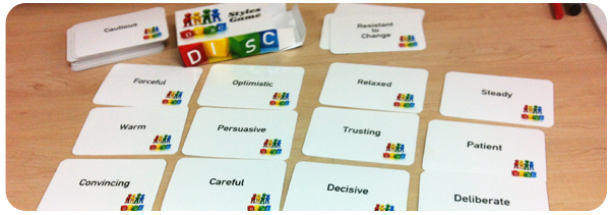DISC Famous Faces Game
This article explores how you might introduce DISC to a business team, whether it is part of leadership development program, sales / customer service training, or any kind of team building / communication skills workshop. There is no single best way to introduce DISC. What follows is simply one example to help those who are looking for ways to make their training more fun and engaging right from the start.
Famous Faces Instructions:
Have the “Styles Game” cards spread out on the table before the participants walk into the room. Once they are seated, put up an image (on a PowerPoint slide or hand-out) of four sets of famous celebrities or movie/TV characters.

Then say to the group:
“I have a problem-solving challenge for you. I want you to try and work out the following: What does each row of famous people have in common that’s different to the other three rows? In front of you, spread out on the table, you will notice a pile of cards with individual words printed — one per card. Your job is to work out which words correspond to which row. Each word fits with one of the four categories.”

For more famous movie/celebrity examples see: DISC Famous Characters
Facilitation options:
You can ask participants to tackle the task as a group, individually, in pairs, or in teams (depending on group size)
- Works best if participants pick around 3-5 words per row
- You may wish to give them a time limit, e.g. 1, 2 or 3 minutes
- Ask each participant/group to explain their choices and reasoning.
Once the game is over, then explain the purpose. For example:
“The purpose of this exercise was to get you thinking about behaviour. By behaviour, I mean the common ways in which people tend to act and communicate. More than 50 years of research has proven that all people on earth tend to behave in similar ways. In fact, if you were to spend centuries watching people and taking notes on all the ways that people around the world commonly tend to behave, you would find these observations could be broken into four categories.
The ancient Greeks called these categories the four temperaments. Today, tens of thousands of businesses around the world use a four-letter acronym called DISC, which is a valid and reliable assessment tool that is used to gauge exactly how high you score in each of these four styles/categories.
You may already feel like you relate to one of these four sets of famous faces more than the other three. But it’s important to keep in mind that it’s not just a case of saying you are only one category; it’s a case of understanding your overall preference across all four factors.
As part of this workshop, we’ll take the time to look at exactly what the DISC framework is. We’ll also explore the DISC profiles that you took earlier in the week, and we’ll get to look at your graphs and understand how they work. Ultimately, we want to see what information in the DISC report can be used to help you be more effective in your work. (Whether it be to improve self-awareness, communication, teamwork, trust, ability to sell/influence, build rapport, manage ourselves more effectively, etc.)
Okay let’s get started. Does anyone want to have a guess at what DISC stands for?"
Topics:
DISC Profile
Theo Winter
Client Services Manager, Writer & Researcher. Theo is one of the youngest professionals in the world to earn an accreditation in TTI Success Insight's suite of psychometric assessments. For more than a decade, he worked with hundreds of HR, L&D and OD professionals and consultants to improve engagement, performance and emotional intelligence of leaders and their teams. He authored the book "40 Must-Know Business Models for People Leaders."

/emotional%20quotient%20in%20leadership%20development.png?width=374&name=emotional%20quotient%20in%20leadership%20development.png)
/Disc%20profile%20in%20leadership%20development.png?width=374&name=Disc%20profile%20in%20leadership%20development.png)
We Would Like to Hear From You (0 Comments)